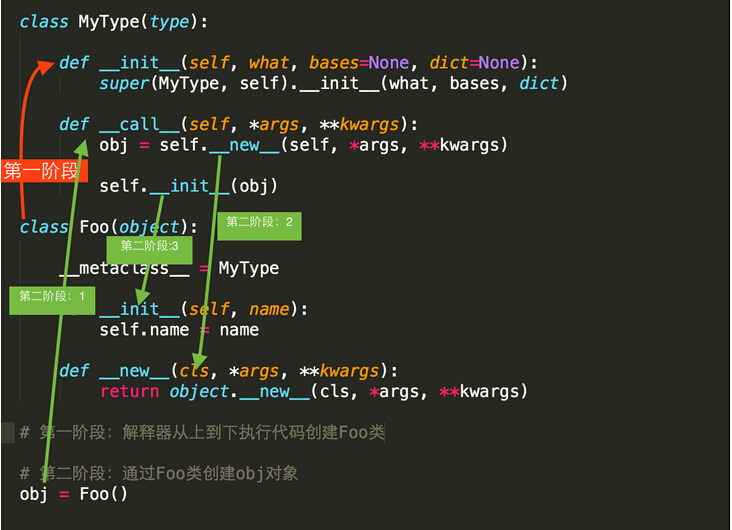1. __doc__
表示类的描述信息
|
1
2
3
4
5
6
7
8
9
|
class Foo: """ 描述类信息,这是用于看片的神奇 """ def func(self): passprint Foo.__doc__==============描述类信息,这是用于看片的神奇 |
2. __module__ 和 __class__
__module__ 表示当前操作的对象在哪个模块
__class__ 表示当前操作的对象的类是什么
3. __init__
构造方法,通过类创建对象时,自动触发执行。
|
1
2
3
4
5
6
7
8
9
|
class Foo: def__init__(self, name): self.name = name self.age = 18obj = Foo('wupeiqi')# 自动执行类中的 __init__ 方法 |
4. __del__
析构方法,当对象在内存中被释放时,自动触发执行。
注:此方法一般无须定义,因为Python是一门高级语言,程序员在使用时无需关心内存的分配和释放,因为此工作都是交给Python解释器来执行,所以,析构函数的调用是由解释器在进行垃圾回收时自动触发执行的。
|
1
2
3
4
|
class Foo: def__del__(self): pass |
5. __call__
对象后面加括号,触发执行。
注:构造方法的执行是由创建对象触发的,即:对象 = 类名() ;而对于 __call__ 方法的执行是由对象后加括号触发的,即:对象() 或者 类()()
|
1
2
3
4
5
6
7
8
|
class Foo: def__init__(self): passdef__call__(self, *args, **kwargs): print'__call__'obj = Foo() # 执行 __init__obj() # 执行 __call__ |
6. __dict__
类或对象中的所有成员
上文中我们知道:类的普通字段属于对象;类中的静态字段和方法等属于类,即:

|
1
2
3
4
5
6
7
8
9
10
11
12
13
14
15
16
17
18
19
|
class Province: country = 'China' def__init__(self, name, count): self.name = name self.count = count def func(self, *args, **kwargs): print'func'# 获取类的成员,即:静态字段、方法...print Province.__dict__# 输出:{'country': 'China', '__module__': '__main__', 'func': <function func at 0x10be30f50>, '__init__': <function __init__ at 0x10be30ed8>, '__doc__': None}# 获取 对象obj1 的成员obj1 = Province('HeBei',10000)print obj1.__dict__# 输出:{'count': 10000, 'name': 'HeBei'} |
7. __str__
如果一个类中定义了__str__方法,那么在打印 对象 时,默认输出该方法的返回值。
|
1
2
3
4
5
6
7
|
class Foo: def__str__(self): return'wupeiqi'obj = Foo()print obj# 输出:wupeiqi |
8、__getitem__、__setitem__、__delitem__
用于索引操作,如字典。以上分别表示获取、设置、删除数据
|
1
2
3
4
5
6
7
8
9
10
11
12
13
14
15
16
17
18
19
|
#!/usr/bin/env python# -*- coding:utf-8 -*- class Foo(object): def __getitem__(self, key): print '__getitem__',key def __setitem__(self, key, value): print '__setitem__',key,value def __delitem__(self, key): print '__delitem__',key obj = Foo() result = obj['k1'] # 自动触发执行 __getitem__obj['k2'] = 'wupeiqi' # 自动触发执行 __setitem__del obj['k1'] # 自动触发执行 __delitem__ |
9、__getslice__、__setslice__、__delslice__
该三个方法用于分片操作,如:列表 slice : 切片 切割
|
1
2
3
4
5
6
7
8
9
10
11
12
13
14
15
16
17
18
19
|
#!/usr/bin/env python# -*- coding:utf-8 -*- class Foo(object): def __getslice__(self, i, j): print '__getslice__',i,j def __setslice__(self, i, j, sequence): print '__setslice__',i,j def __delslice__(self, i, j): print '__delslice__',i,jobj = Foo() obj[-1:1] # 自动触发执行 __getslice__obj[0:1] = [11,22,33,44] # 自动触发执行 __setslice__del obj[0:2] # 自动触发执行 __delslice__ |
10. __iter__
用于迭代器,之所以列表、字典、元组可以进行for循环,是因为类型内部定义了 __iter__
第一步:
|
1
2
3
4
5
6
7
8
9
|
class Foo(object): passobj = Foo()for i in obj: print i # 报错:TypeError: 'Foo' object is not iterable 可迭代的 |
第二步:
|
1
2
3
4
5
6
7
8
9
10
11
12
13
|
#!/usr/bin/env python# -*- coding:utf-8 -*-class Foo(object): def__iter__(self): passobj = Foo()for i in obj: print i# 报错:TypeError: iter() returned non-iterator of type 'NoneType' |
第三步:
|
1
2
3
4
5
6
7
8
9
10
11
12
13
14
|
#!/usr/bin/env python# -*- coding:utf-8 -*-class Foo(object): def__init__(self, sq): self.sq = sq def__iter__(self): return iter(self.sq)obj = Foo([11,22,33,44])for i in obj: print i |
以上步骤可以看出,for循环迭代的其实是 iter([11,22,33,44]) ,所以执行流程可以变更为:
|
1
2
3
4
5
6
7
8
9
10
11
12
13
14
15
16
17
|
#!/usr/bin/env python# -*- coding:utf-8 -*- obj = iter([11,22,33,44]) for i in obj: print iFor循环语法内部#!/usr/bin/env python# -*- coding:utf-8 -*-obj = iter([11,22,33,44])while True: val = obj.next() print val |
11. __new__ 和 __metaclass__
|
1
|
<span style="font-family: 'Microsoft YaHei';"><strong>阅读以下代码:</strong></span> |
|
1
2
3
4
5
6
|
class Foo(object): def __init__(self): pass obj = Foo() # obj是通过Foo类实例化的对象 |
上述代码中,obj 是通过 Foo 类实例化的对象,其实,不仅 obj 是一个对象,Foo类本身也是一个对象,因为在Python中一切事物都是对象。
如果按照一切事物都是对象的理论:obj对象是通过执行Foo类的构造方法创建,那么Foo类对象应该也是通过执行某个类的 构造方法 创建。
|
1
2
|
print type(obj) # 输出:<class '__main__.Foo'> 表示,obj 对象由Foo类创建print type(Foo) # 输出:<type 'type'> 表示,Foo类对象由 type 类创建 |
所以,obj对象是Foo类的一个实例,Foo类对象是 type 类的一个实例,即:Foo类对象 是通过type类的构造方法创建。
那么,创建类就可以有两种方式:
a). 普通方式
|
1
2
3
4
|
class Foo(object): def func(self): print 'hello wupeiqi' |
b).特殊方式(type类的构造函数)
|
1
2
3
4
5
6
7
|
def func(self): print 'hello wupeiqi' Foo = type('Foo',(object,), {'func': func})#type第一个参数:类名#type第二个参数:当前类的基类#type第三个参数:类的成员 |
==》 类 是由 type 类实例化产生 